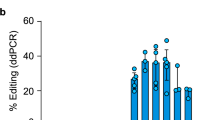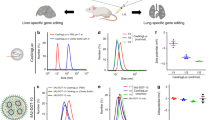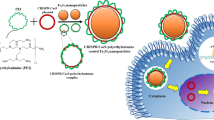Abstract
Delivery technologies for the CRISPR-Cas9 (CRISPR, clustered regularly interspaced short palindromic repeats) gene editing system often require viral vectors, which pose safety concerns for therapeutic genome editing1. Alternatively, cationic liposomal components or polymers can be used to encapsulate multiple CRISPR components into large particles (typically >100 nm diameter); however, such systems are limited by variability in the loading of the cargo. Here, we report the design of customizable synthetic nanoparticles for the delivery of Cas9 nuclease and a single-guide RNA (sgRNA) that enables the controlled stoichiometry of CRISPR components and limits the possible safety concerns in vivo. We describe the synthesis of a thin glutathione (GSH)-cleavable covalently crosslinked polymer coating, called a nanocapsule (NC), around a preassembled ribonucleoprotein (RNP) complex between a Cas9 nuclease and an sgRNA. The NC is synthesized by in situ polymerization, has a hydrodynamic diameter of 25 nm and can be customized via facile surface modification. NCs efficiently generate targeted gene edits in vitro without any apparent cytotoxicity. Furthermore, NCs produce robust gene editing in vivo in murine retinal pigment epithelium (RPE) tissue and skeletal muscle after local administration. This customizable NC nanoplatform efficiently delivers CRISPR RNP complexes for in vitro and in vivo somatic gene editing.
This is a preview of subscription content, access via your institution
Access options
Access Nature and 54 other Nature Portfolio journals
Get Nature+, our best-value online-access subscription
$29.99 / 30 days
cancel any time
Subscribe to this journal
Receive 12 print issues and online access
$259.00 per year
only $21.58 per issue
Buy this article
- Purchase on Springer Link
- Instant access to full article PDF
Prices may be subject to local taxes which are calculated during checkout




Similar content being viewed by others
Data availability
The data that support the plots within this paper and other findings of this study are available from the corresponding authors upon reasonable request.
References
Yin, H., Kauffman, K. J. & Anderson, D. G. Delivery technologies for genome editing. Nat. Rev. Drug Discov. 16, 387–399 (2017).
Liu, J. et al. Efficient delivery of nuclease proteins for genome editing in human stem cells and primary cells. Nat. Protocols 10, 1842–1859 (2015).
Li, L., He, Z., Wei, X., Gao, G. & Wei, Y. Challenges in CRISPR/CAS9 delivery: potential roles of nonviral vectors. Hum. Gene Ther. 26, 452–462 (2015).
Mout, R., Ray, M., Lee, Y. W., Scaletti, F. & Rotello, V. M. In vivo delivery of CRISPR/Cas9 for therapeutic gene editing: progress and challenges. Bioconjugate Chem. 28, 880–884 (2017).
Wang, H. X. et al. CRISPR/Cas9-based genome editing for disease modeling and therapy: challenges and opportunities for nonviral delivery. Chem. Rev. 117, 9874–9906 (2017).
Li, L., Hu, S. & Chen, X. Non-viral delivery systems for CRISPR/Cas9-based genome editing: challenges and opportunities. Biomaterials 171, 207–218 (2018).
Rui, Y., Wilson, D. R. & Green, J. J. Non-viral delivery to enable genome editing. Trends Biotechnol. 37, 281–293 (2019).
Gu, Z. et al. Protein nanocapsule weaved with enzymatically degradable polymeric network. Nano Lett. 9, 4533–4538 (2009).
Zhao, M. et al. Clickable protein nanocapsules for targeted delivery of recombinant p53 protein. J. Am. Chem. Soc. 136, 15319–15325 (2014).
Yan, M. et al. A novel intracellular protein delivery platform based on single-protein nanocapsules. Nat. Nanotechnol. 5, 48–53 (2010).
Putnam, D., Gentry, C. A., Pack, D. W. & Langer, R. Polymer-based gene delivery with low cytotoxicity by a unique balance of side-chain termini. Proc. Natl Acad. Sci. USA 98, 1200–1205 (2001).
Meng, F., Cheng, R., Deng, C. & Zhong, Z. Intracellular drug release nanosystems. Mater. Today 15, 436–442 (2012).
Liu, F. et al. PKM2 methylation by CARM1 activates aerobic glycolysis to promote tumorigenesis. Nat. Cell Biol. 19, 1358–1370 (2017).
Mout, R. et al. Direct cytosolic delivery of CRISPR/Cas9-ribonucleoprotein for efficient gene editing. ACS Nano 11, 2452–2458 (2017).
Carlson-Stevermer, J. et al. High-content analysis of CRISPR-Cas9 gene-edited human embryonic stem cells. Stem Cell Rep. 6, 109–120 (2016).
Carlson-Stevermer, J. et al. Assembly of CRISPR ribonucleoproteins with biotinylated oligonucleotides via an RNA aptamer for precise gene editing. Nat. Commun. 8, 1711 (2017).
Elzes, M. R., Akeroyd, N., Engbersen, J. F. & Paulusse, J. M. Disulfide-functional poly(amido amine)s with tunable degradability for gene delivery. J. Control. Release 244, 357–365 (2016).
Staahl, B. T. et al. Efficient genome editing in the mouse brain by local delivery of engineered Cas9 ribonucleoprotein complexes. Nat. Biotechnol. 35, 431–434 (2017).
Payton, N. M., Wempe, M. F., Xu, Y. & Anchordoquy, T. J. Long-term storage of lyophilized liposomal formulations. J. Pharm. Sci. 103, 3869–3878 (2014).
Chen, G. et al. Multi-functional self-fluorescent unimolecular micelles for tumor-targeted drug delivery and bioimaging. Biomaterials 47, 41–50 (2015).
Sun, J. et al. CRISPR/Cas9 editing of APP C-terminus attenuates β-cleavage and promotes α-cleavage. Nat. Commun. 10, 53 (2019).
Berger, W., Kloeckener-Gruissem, B. & Neidhardt, J. The molecular basis of human retinal and vitreoretinal diseases. Prog. Retin. Eye Res. 29, 335–375 (2010).
Maeder, M. L. et al. Development of a gene-editing approach to restore vision loss in Leber congenital amaurosis type 10. Nat. Med. 25, 229–233 (2019).
Sun, D. et al. Targeted multifunctional lipid ECO plasmid DNA nanoparticles as efficient non-viral gene therapy for Leber’s congenital amaurosis. Mol. Ther. Nucleic Acids 7, 42–52 (2017).
Marmor, M. F. Control of subretinal fluid: experimental and clinical studies. Eye 4, 340–344 (1990).
Strauss, O. The retinal pigment epithelium in visual function. Physiol. Rev. 85, 845–881 (2005).
Mao, Y. & Finnemann, S. C. in Retinal Degeneration (eds Weber, B. & Langmann, T.) 285–295 (Springer, 2012).
Mazzoni, F., Mao, Y. & Finnemann, S. C. in Retinal Degeneration (eds Weber, B. & Langmann, T.) 95–108 (Springer, 2019).
Steyer, B. et al. High content analysis platform for optimization of lipid mediated CRISPR-Cas9 delivery strategies in human cells. Acta Biomater. 34, 143–158 (2016).
Zuris, J. A. et al. Cationic lipid-mediated delivery of proteins enables efficient protein-based genome editing in vitro and in vivo. Nat. Biotechnol. 33, 73–80 (2015).
Harkness, T. et al. High‐content imaging with micropatterned multiwell plates reveals influence of cell geometry and cytoskeleton on chromatin dynamics. Biotechnol. J. 10, 1555–1567 (2015).
Park, J., Lim, K., Kim, J. S. & Bae, S. Cas-analyzer: an online tool for assessing genome editing results using NGS data. Bioinformatics 33, 286–288 (2017).
Acknowledgements
We thank the James Thomson lab for the use of their BD FACSCanto II, and the University of Wisconsin Biotechnology Center for providing facilities and services. We thank Aldevron for supplying reagents and technical support. We are grateful to Q. Chang who provided us with the Ai14 tdTomato transgenic mice used for the initial evaluation. We acknowledge the generous financial support from the National Institute for Health (1-UG3-NS-111688-01, R01EY024995, 1R35GM119644, R01NS091540, R01HL143469 and R01 HL129785), the National Science Foundation (CBET-1350178 and CBET-1645123), the Wisconsin Alumni Research Foundation and the Wisconsin Institute for Discovery. The authors also acknowledge financial support from the University of Wisconsin–Madison.
Author information
Authors and Affiliations
Contributions
G.C., A.A.A., Y.W., K.S. and S.G. conceived and designed the project, G.C., A.A.A., Y.W., R.X., M.S., S.R. and P.K.S. performed the experiments, all the authors analysed the data and G.C., A.A.A., Y.W., P.K.S., B.R.P., M.S., K.S. and S.G. co-wrote the paper.
Corresponding authors
Ethics declarations
Competing interests
G.C., A.A.A., Y.W., R.X., K.S. and S.G. have filed a patent application on this work.
Additional information
Publisher’s note: Springer Nature remains neutral with regard to jurisdictional claims in published maps and institutional affiliations.
Supplementary information
Supplementary and Additional Material
Supplementary Figs. 1–6 and Table 1.
Rights and permissions
About this article
Cite this article
Chen, G., Abdeen, A.A., Wang, Y. et al. A biodegradable nanocapsule delivers a Cas9 ribonucleoprotein complex for in vivo genome editing. Nat. Nanotechnol. 14, 974–980 (2019). https://doi.org/10.1038/s41565-019-0539-2
Received:
Accepted:
Published:
Issue Date:
DOI: https://doi.org/10.1038/s41565-019-0539-2
This article is cited by
-
Finely tuned ionizable lipid nanoparticles for CRISPR/Cas9 ribonucleoprotein delivery and gene editing
Journal of Nanobiotechnology (2024)
-
Strategies for non-viral vectors targeting organs beyond the liver
Nature Nanotechnology (2024)
-
Traceless photodegradable polymer cocoons for universal protein delivery and light-controlled gene editing
Science China Chemistry (2024)
-
In vitro transcription of self-assembling DNA nanoparticles
Scientific Reports (2023)
-
Drug delivery systems for CRISPR-based genome editors
Nature Reviews Drug Discovery (2023)



